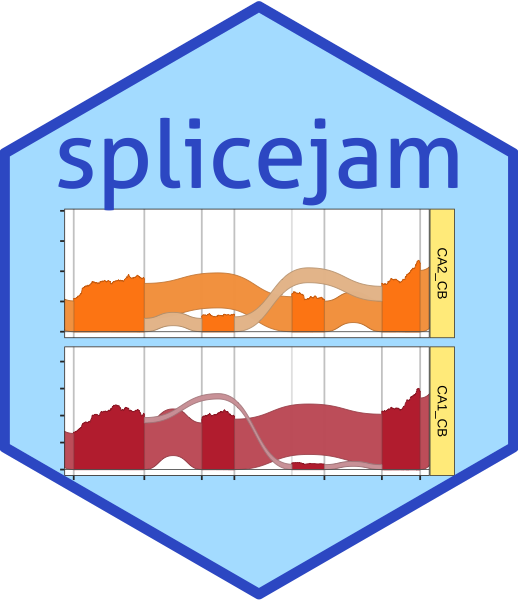"Jam" suite of data analysis R packages, splicejam sashimi plots, and supporting methods used in Farris et al, 2019. Hippocampal Subregions Express Distinct Dendritic Transcriptomes that Reveal Differences in Mitochondrial Function in CA2
devtools::install_github("jmw86069/jampack")
- splicejam: Sashimi plots, splicejam R-shiny Sashimi app, various supporting functions for RNA-seq and gene transcript isoform analysis.
- jamba: Jam Base functions
- jamma: Jam MA-plots
- colorjam: Jam color functions
- multienrichjam: Multi enrichment analysis
Each "jampack" R package includes online documentation
linked to its Github page, created by "pkgdown".
Most functions contain examples with online figures
where applicable.
Methods used in Farris et al, 2019
An Rmarkdown file was prepared to reproduce and demonstrate the analysis steps used for RNA-seq and microarray analysis, and which re-creates the figures in the manuscript. This Rmarkdown file was used to produce an HTML summary:
HTML summary of methods in Farris et al, 2019
Supporting data for Farris et al, 2019
Additional data required for the Rmarkdown analysis is provided in an R package "farrisdata". This package can be installed via Github using:
devtools::install_github("jmw86069/farrisdata")
In addition to installing the "farrisdata" package, install "jampack":
devtools::install_github("jmw86069/jampack")
The "jampack" package will install other R package dependencies and should be sufficient to reproduce the full Rmarkdown HTML output.
Note that "jampack" itself does not require "farrisdata" in order to avoid having to install a large data package in order to use the RNA-seq analysis functions. Similarly, the "farrisdata" package does not require "jampack" since the data itself useful independent of the "jampack" R packages.
- Make sure to install "jampack" with all dependencies:
devtools::install_github("jmw86069/jampack", dependencies=TRUE);
- Download the file "farrisSeq.Rmd"
- Move this file to a convenient folder. Cache files and images will be stored in this folder as a result of the analysis steps.
- Open an R session in the folder where the file was saved, then run this command in R:
rmarkdown::render("farrisSeq.Rmd", "html_document", knit_root_dir=getwd(), output_dir=getwd())
- Note that when you run
rmarkdown::render()it will also populate the active R session with the R objects used, which can be a convenient way to inspect the data. - Alternatively, open the
farrisSeq.Rmdfile in Rstudio, and click"Knit"to render the document in HTML. Note that when you use "Knit" in Rstudio, it does not populate the data into the active R session by default.
-
You may need to install the tool
"pandoc", as described https://pandoc.org. If you are unable to install Pandoc, note that Rstudio also installs its own"pandoc", which can be used outside of Rstudio. To do so, add the path to the folder containing pandoc to the environment variablePATH. -
R package dependencies are sometimes difficult to resolve, but some common errors we observed:
- Some Bioconductor packages require a higher version of R,
we have tested and verified versions
R-3.5.*andR-3.6.*. - The (amazing) package "ComplexHeatmap" must be version
1.99.5or higher, as of April 2019 required the Github R package; as of October 2019 any official Bioconductor release version 2.0.0 should be sufficient. If you see error messages related to ComplexHeatmap, you may try the Github development version withdevtools::install_github("jokergoo/ComplexHeatmap"). - Other required packages should be installed and imported, but in some cases it is helpful to load the package into the user environment. For example if a function is not available, loading its source package can be a workaround. If you encounter such issues, please let us know by filing a Github issue. We are trying to reduce package dependencies meanwhile.
- Some Bioconductor packages require a higher version of R,
we have tested and verified versions
-
Please file an issue in Github describing the steps you tried, and the error message you received. It will fill us with happiness to know that somebody has tried to use the tools, and cares enough to help us improve.
-
Expert mode: Clone the Github repository, make the fix or update, then send a pull request to include your updates into the repository.

